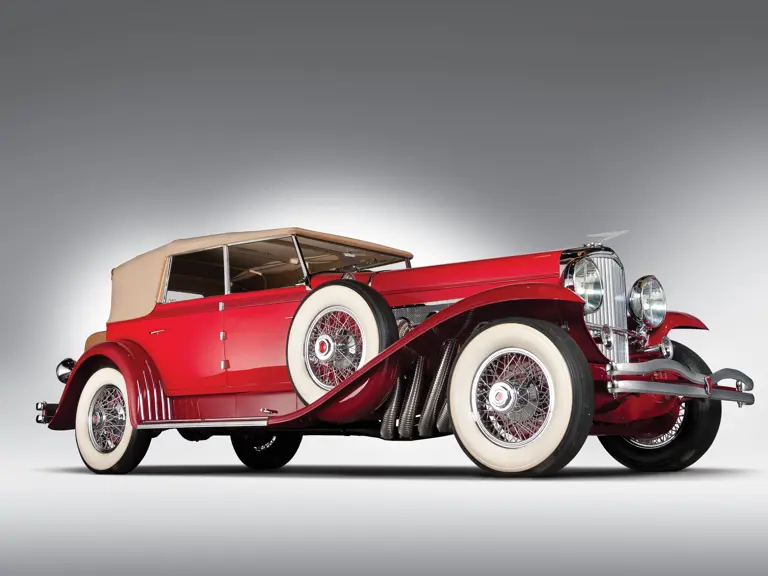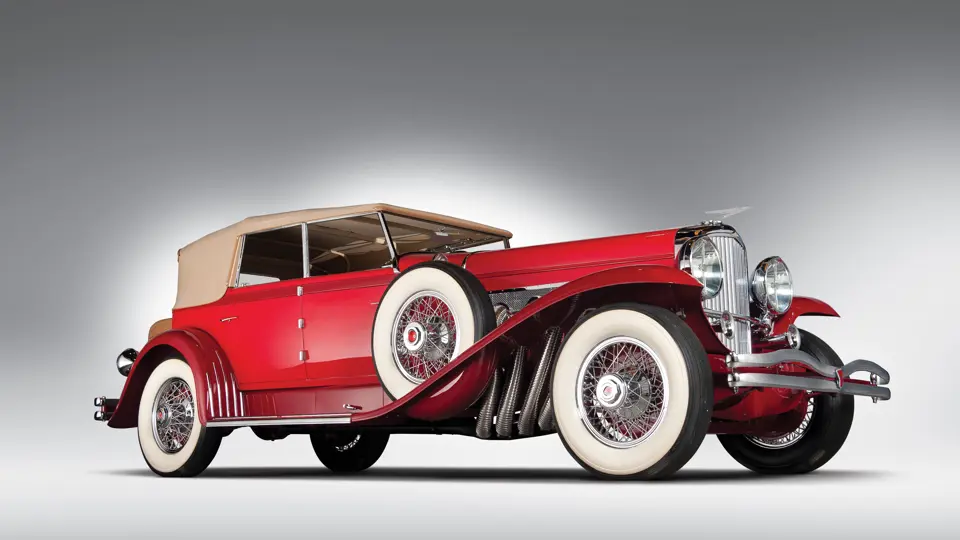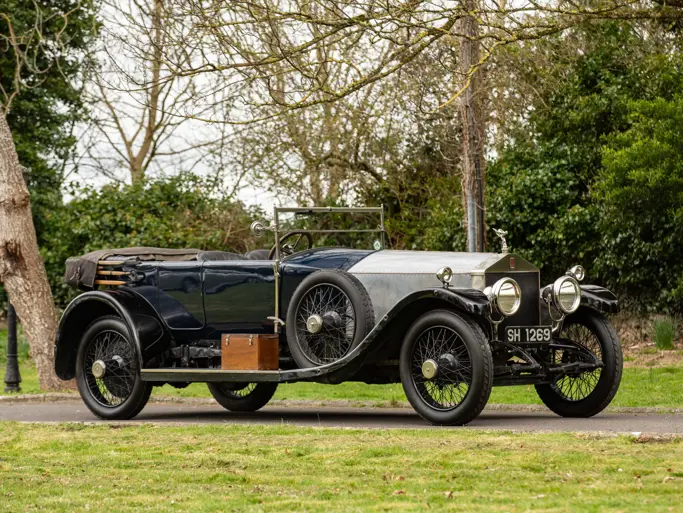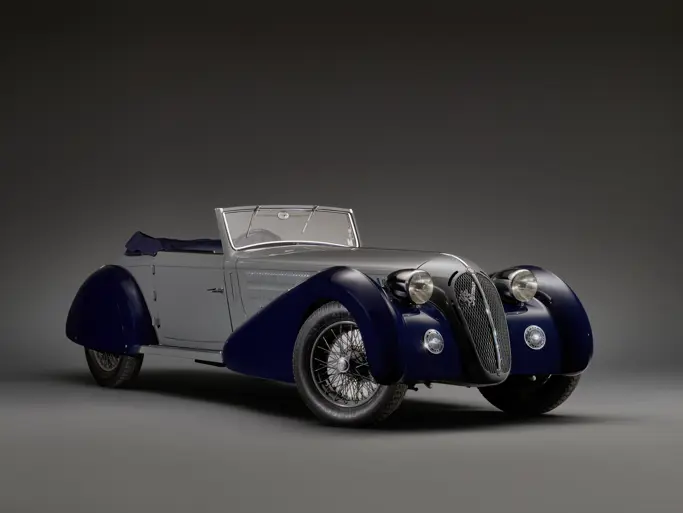265 bhp, 420 cu. in. OHC inline eight-cylinder engine, three-speed manual transmission, solid front axle and live rear axle with semi-elliptic leaf springs, and four-wheel hydraulic drum brakes. Wheelbase: 142.5"
• Classic Model J Duesenberg
• Timeless Murphy coachwork
• Believed to have been owned by famed film star Delores Del Rio
• Original chassis/engine
Many superlative automobiles have been built during the century-plus history of self-propelled travel, but few have spawned new words for our lexicon. It is a testament to the Duesenberg Model J that anything great or grand is called a “doozie” (by various spellings).
While its creators, Frederick and August Duesenberg, are best remembered for the immortal Model J, they earned their reputations building race cars. As a result, competition technology found its way into all the high-performance automobiles they built for the road.
The Duesenberg Model J was introduced at the New York Auto Salon on December 1, 1928. It made headlines. The com¬bination of the Duesenberg reputation with the Model J’s grandeur and elegance made it the star of the show. The effect of the Duesenberg J on America can’t be overstated. Even in the depths of the Depression, this paragon of power was a portent of prosperity. Duesenberg’s advertising became a benchmark, featuring the wealthy and privileged in opulent sur¬roundings with only a single line of copy: “He drives a Duesenberg” or “She drives a Duesenberg.” The external exhaust pipes of the supercharged models inspired generations of auto designers and remain—more than four score years later—a symbol of power and performance.
Despite having body companies of his own, Central Body Company of Connellsville, Indiana and Union City Body Company of Union City, Indiana, E.L. Cord relied heavily on outside, more upscale clothiers for his marquee marque. Duesenberg customers could, of course, order their own bodies from coachbuilders of their choice, but Duesenberg, Inc., as it became known, also purchased directly from coachbuilders, although in very small quantities. Among the suppliers were Willoughby, Derham, LeBaron, Judkins, American Weymann, Walker, Brunn, Holbrook and Locke, a veritable who’s who of American craftsmanship. Quantities from these constructors ranged from 50 to one. By far the most popular coachbuilder was the Walter M. Murphy Company of Pasadena, California.
The lovely Duesenberg offered here, J208, chassis 2228, was built new with Murphy Convertible Sedan coachwork, which it still wears today. Initially used as a demonstrator by the New York factory branch, it was fitted with a honeycomb radiator, wooden running boards and Marchal reflectors and lenses. Later the car was transferred to Los Angeles where it served again as a demonstrator before being sold to a J. Ryan, sometime in 1933. Ryan kept the car for a year before passing it on to Cedric Gibbons, a talented art director and set designer from Hollywood who was married to film star Dolores del Rio.
Mr. Gibbons was one of MGM’s leading art directors and production designers, whom Del Rio met at a party organized by William Randolph Hearst and Marion Davies at Hearst Castle. Born into a wealthy Mexican family of Spanish ancestry, Del Rio was an established Hollywood star in her own right and a fixture in high society circles as their home in Hollywood was a frequent meeting place of such personalities as Greta Garbo, Marlene Dietrich and Clark Gable. Generally thought to be one of the prettiest actresses of her era, she was the first Latin American movie star with international appeal and was considered a counterpart to Rudolph Valentino and often called the “Princess of Mexico.” In fact, her marriage to Gibbons ended in the wake of her relationship with Orson Welles, who later married Rita Hayworth.
From that time forward, the Duesenberg remained in California for many years. The next owner of record was Bob Roberts, another Los Angeles resident, who purchased the car in the late 1930s. Roberts, who switched the engine with J488, then sold the car to Joe Reindl, who kept the car during the war years before selling it to Frank Ehrlin of Palo Alto, probably in 1946.
In 1958 Ed Bernhard of Coronado, California acquired the car, and it remained with him for nearly two decades before it was purchased by Phil Renick of Fullerton, California in 1977.
Renick engaged noted Duesenberg historian and restorer Randy Ema of Orange, California to reunite 2228 with its original engine J208, which it retains to this day.
In 1986, the Duesenberg passed to well known L.A. area collector Bruce Meyer, who immediately commissioned Randy Ema to undertake a full professional restoration to concours condition. Upon completion in 1987, J208 was recognized with a first place at Pebble Beach, followed by numerous Best of Show awards.
Bruce Meyer kept the car for two more years before selling it to racing legend Andy Granatelli, who kept the car for several years before its acquisition by the Milhous brothers.
J208 still presents very well in solid red with subtle maroon moldings and a tan canvas top. Body and paint are in excellent condition, and the top is of the same caliber. The brightwork including the original Marchal headlamps, is excellent. The interior is done in tan leather, with brown carpet on the floor. The engine is superbly detailed, painted green in contrast to polished aluminum, while the chassis and running gear match the red body. Tires are 7.00x19 Lester wide whitewalls, which look excellent. A brown, leather-covered trunk at the rear contains tools and a top boot.
A spectacular car with celebrity history, this Duesenberg presents a striking appearance wherever it goes. Its stunning Murphy coachwork is certainly befitting a movie star and red carpet event.




 | Boca Raton, Florida
| Boca Raton, Florida


